Linux dialog详解(图形化shell)
作者:服务器运维 • 更新时间:2023-08-21 •
最近使用dialog写图形自动化shell脚本, 功能很强大,功能不是非常多但是足够用。想写一篇linux下dialog的使用方法,虽然命令不多,但是写起来也需要下很大功夫,而且不一定写得更好,在网上发现一篇linux shell图形化脚本文件,于是转过来了.
liunx 下的dialog 工具是一个可以和shell脚本配合使用的文本界面下的创建对话框的工具。
每个对话框提供的输出有两种形式:
1. 将所有输出到stderr 输出,不显示到屏幕。
2. 使用退出状态码,“OK”为0,“NO”为1,"ESC"为255
通用选项 common options:(这个选项来设置dialog box的背景,颜色和 标题等)[--title <title>] 指定将在对话框的上方显示的标题字符串
[--colors] 解读嵌入式“\ Z”的对话框中的特殊文本序列,序列由下面的字符 0-7, b B, u, U等,恢复正常的设置使用“\Zn”。
[--no-shadow] 禁止阴影出现在每个对话框的底部
[--shadow] 应该是出现阴影效果[--insecure] 输入部件的密码时,明文显示不安全,使用星号来代表每个字符[--no-cancel] 设置在输入框,菜单,和复选框中,不显示“cancel”项
[--clear] 完成清屏操作。在框体显示结束后,清除框体。这个参数只能单独使用,不能和别的参数联合使用。
[--ok-label <str>] 覆盖使用“OK”按钮的标签,换做其他字符。
[--cancel-label <str>] 功能同上
[--backtitle <backtitle>] 指定的backtitle字符串显示在背景顶端。
[--begin <y> <x>] 指定对话框左上角在屏幕的上的做坐标
[--timeout <secs>] 超时(返回的错误代码),如果用户在指定的时间内没有给出相应动作,就按超时处理
[--defaultno] 使的是默认值 yes/no,使用no
[--sleep <secs>]
[--stderr] 以标准错误方式输出
[--stdout] 以标准方式输出
[--default-item <str>] 设置在一份清单,表格或菜单中的默认项目。通常在框中的第一项是默认
[--colors] 解读嵌入式“\ Z”的对话框中的特殊文本序列,序列由下面的字符 0-7, b B, u, U等,恢复正常的设置使用“\Zn”。
[--no-shadow] 禁止阴影出现在每个对话框的底部
[--shadow] 应该是出现阴影效果[--insecure] 输入部件的密码时,明文显示不安全,使用星号来代表每个字符[--no-cancel] 设置在输入框,菜单,和复选框中,不显示“cancel”项
[--clear] 完成清屏操作。在框体显示结束后,清除框体。这个参数只能单独使用,不能和别的参数联合使用。
[--ok-label <str>] 覆盖使用“OK”按钮的标签,换做其他字符。
[--cancel-label <str>] 功能同上
[--backtitle <backtitle>] 指定的backtitle字符串显示在背景顶端。
[--begin <y> <x>] 指定对话框左上角在屏幕的上的做坐标
[--timeout <secs>] 超时(返回的错误代码),如果用户在指定的时间内没有给出相应动作,就按超时处理
[--defaultno] 使的是默认值 yes/no,使用no
[--sleep <secs>]
[--stderr] 以标准错误方式输出
[--stdout] 以标准方式输出
[--default-item <str>] 设置在一份清单,表格或菜单中的默认项目。通常在框中的第一项是默认
窗体类型:
常见的对话框控件选项有:
[ --calendar ] 提供了一个日历,让你可以选择日期
[ --checklist ] 允许你显示一个选项列表,每个选项都可以被单独的选择 (复选框)
[ --from ] 允许您建立一个带标签的文本字段,并要求填写
[ --fselect ] 提供一个路径,让你选择浏览的文件
[ --gauge ] 显示一个表,呈现出完成的百分比,就是显示出进度。
[ --infobox ] 显示消息后,(没有等待响应)对话框立刻返回,但不清除屏幕 (信息框)
[ --inputbox ] 让用户输入文本 (输入框 )
[ --inputmenu ] 提供一个可供用户编辑的菜单 (可编辑的菜单框)
[ --menu ] 显示一个列表供用户选择 (菜单框)
[ --msgbox ] 显示一条消息,并要求用户选择一个确定按钮 (消息框 )
[ --pause ] 显示一个表格用来显示一个指定的暂停期的状态
[ --passwordbox ] 显示一个输入框,它隐藏文本
[ --passwordfrom ] 显示一个来源于标签并且隐藏的文本字段
[ --radiolist ] 提供一个菜单项目组,只有一个项目,可以选择 (单选框 )
[ --tailbox ] 在一个滚动窗口文件中使用tail命令来显示文本
[ --tailboxbg] 跟tailbox类似,但是在background模式下操作
[ --textbox ] 在带有滚动条的文本框中显示文件的内容 (文本框)
[ --timebox ] 提供一个窗口,选择小时,分钟,秒
[ --yesno ] 提供一个带有yes和no按钮的简单信息框 (是/否框)
如果没有此包请先安装
yum -y install dialog
命令示例:
1.消息框 格式:dialog - -msgbox text height width
例子:
#dialog - -title TESTING - -msgbox “this is a test “ 10 20
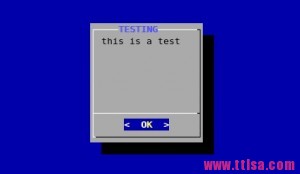
2.yesno框
格式:dialog –yesno text height width
例子:
例子:
#dialog --title "yes/no" --no-shadow --yesno \ "Delete the file /tmp/chensiyao.txt?" 10 30
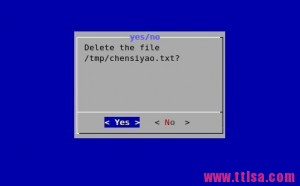
3.输入框
格式:dialog --inputbox text height width
例子:
例子:
# dialog --title "Input your name" \ --inputbox "Please input your name:" 10 30 2> /tmp/name.txt #(这里的2>是将错误信息输出重定向到了/tmp/name.txt文件中)
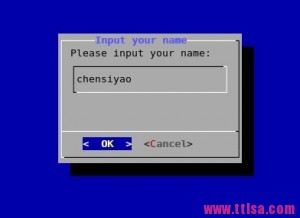 4.密码框
4.密码框格式:
dialog --passwordbox text height width [init]
例子:
# dialog --title "Password" --passwordbox \ "Please give a password for the new user:" 10 35
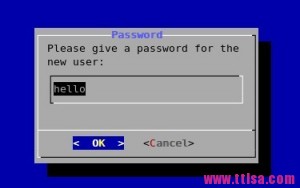
这样我们的密码就暴露出来了,是不是很不安全,所以通常我们会加上一个安全选项
--insecure 将每个字符用*来显示出来
# dialog --title "Password" --insecure \ --passwordbox "Please give a password for the new user:" 10 30
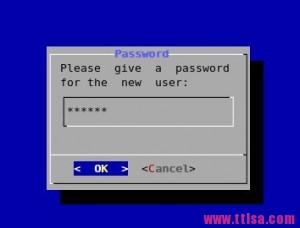
5.文本框
格式:dialog --textbox file height width
例子:
#dialog --title "The fstab" --textbox /etc/fstab 17 40
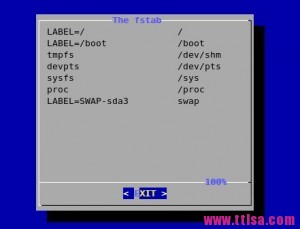
6.菜单框
格式:dialog --menu text height width menu-height tag1 item1 tag2 item2 …
例子:
#dialog --title "Pick a choice" --menu "Choose one" 12 35 5 \ 1 "say hello to everyone" 2 "thanks for your support" 3 "exit"
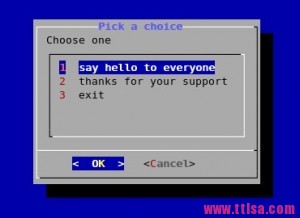
7.Fselect框(文件选框)
格式:dialog --fselect filepath height width
例子:
#dialog --title "Pick one file" --fselect /root/ 7 40
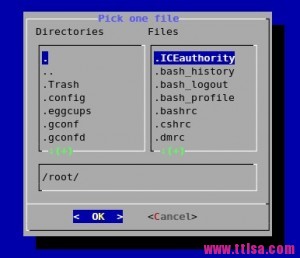
8.复选框
格式:dialog --checklist "Test" height width menu-height tag1 item1 tag2 item2 …
例子:
# dialog --backtitle "Checklist" --checklist "Test" 20 50 10 \ Memory Memory_Size 1 Dsik Disk_Size 2<b></b>

9.显示日历
格式:dialog --calendar "Date" height width day month year
例子:
#显示当前日期
# dialog --title "Calendar" --calendar "Date" 5 50
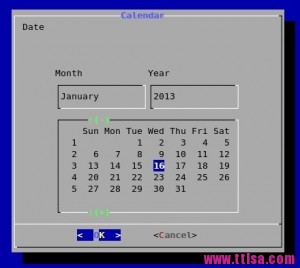
#显示指定日期
# dialog --title "Calendar" --calendar "Date" 5 50 1 2 2013

10.进度框架
格式:dialog --gauge text height width [<percent>]
例子:
#固定进度显示
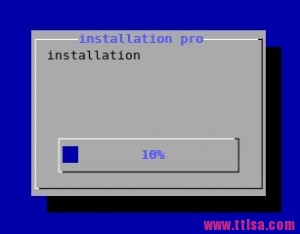
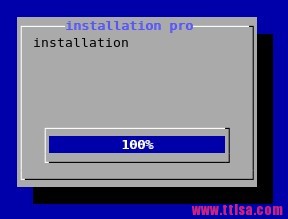
#固定进度显示
#dialog --title "installation pro" --gauge "installation" 10 30 10

#实时动度进度
#for i in {1..100} ;do echo $i;done | dialog --title \
"installation pro" --gauge "installation" 10 30

#编辑到脚本中
编辑一个gauge.sh 的脚本
编辑一个gauge.sh 的脚本
内容如下:
#!/bin/bash # vim gauge.sh declare -i PERCENT=0 ( for I in /etc/*;do if [ $PERCENT -le 100 ];then cp -r $I /tmp/test 2> /dev/null echo "XXX" echo "Copy the file $I ..." echo "XXX" echo $PERCENT fi let PERCENT+=1 sleep 0.1 done ) | dialog --title "coping" --gauge "starting to copy files..." 6 50 0
#bash gauge.sh (执行脚本的时候注意修改权限)

11.from框架(表单)
格式:dialog --form text height width formheight [ label y x item y x flen ilen ] ...
其中
flen 表示field length,定义了:选定字段中显示的长度
ilen 表示 input-length, 定义了:在外地输入的数据允许的长度
使用up/down(或ctrl/ N,ctrl/ P)在使用领域之间移动。使用tab键在窗口之间切换。
例子:
# dialog --title "Add a user" --form "Please input the infomation of new user:" 12 40 4 \
"Username:" 1 1 "" 1 15 15 0 \
"Full name:" 2 1 "" 2 15 15 0 \
"Home Dir:" 3 1 "" 3 15 15 0 \
"Shell:" 4 1 "" 4 15 15 0
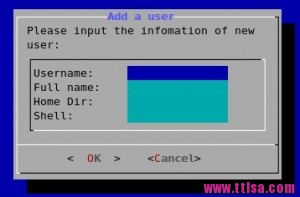
综合应用示例:
#!/bin/bash
yesno() {
dialog --title "First screen" --backtitle "Test Program" --clear --yesno \
"Start this test program or not ? \nThis decesion have to make by you. " 16 51
# yes is 0, no is 1 , esc is 255
result=$?
if [ $result -eq 1 ] ; then
exit 1;
elif [ $result -eq 255 ]; then
exit 255;
fi
username
}
username() {
cat /dev/null >/tmp/test.username
dialog --title "Second screen" --backtitle "Test Program" --clear --inputbox \
"Please input your username (default: hello) " 16 51 "hello" 2>/tmp/test.username
result=$?
if [ $result -eq 1 ] ; then
yesno
elif [ $result -eq 255 ]; then
exit 255;
fi
password
}
password() {
cat /dev/null >/tmp/test.password
dialog --insecure --title "Third screen" --backtitle "Test Program" --clear --passwordbox \
"Please input your password (default: 123456) " 16 51 "123456" 2>/tmp/test.password
result=$?
if [ $result -eq 1 ] ; then
username
elif [ $result -eq 255 ]; then
exit 255;
fi
occupation
}
occupation() {
cat /dev/null >/tmp/test.occupation
dialog --title "Forth screen" --backtitle "Test Program" --clear --menu \
"Please choose your occupation: (default: IT)" 16 51 3 \
IT "The worst occupation" \
CEO "The best occupation" \
Teacher "Not the best or worst" 2>/tmp/test.occupation
result=$?
if [ $result -eq 1 ] ; then
password
elif [ $result -eq 255 ]; then
exit 255;
fi
finish
}
finish() {
dialog --title "Fifth screen" --backtitle "Test Program" --clear --msgbox \
"Congratulations! The test program has finished!\n Username: $(cat /tmp/test.username)\n Password: $(cat /tmp/test.password)\n Occupation: $(cat /tmp/test.occupation)" 16 51
result=$?
if [ $result -eq 1 ] ; then
occupation
elif [ $result -eq 255 ]; then
exit 255;
fi
}
yesno

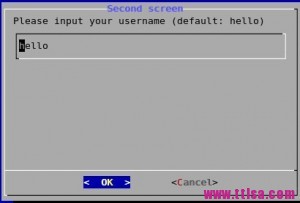
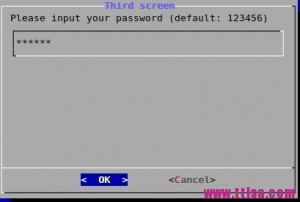
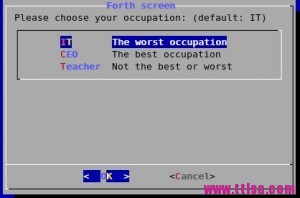
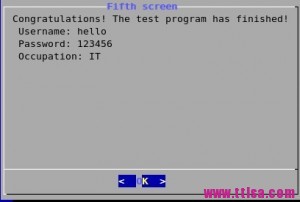
本文转自:http://gdcsy.blog.163.com/blog/static/1273436092013016069255/
本站整理:http://www.ttlsa.com/html/3085.html
本文由主机测评网发布,不代表主机测评网立场,转载联系作者并注明出处:https://zhujiwo.jb51.net/yunwei/8250.html

